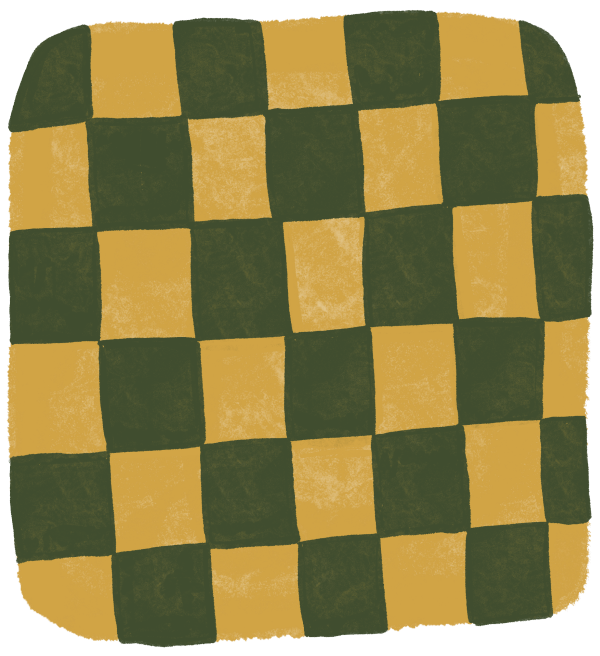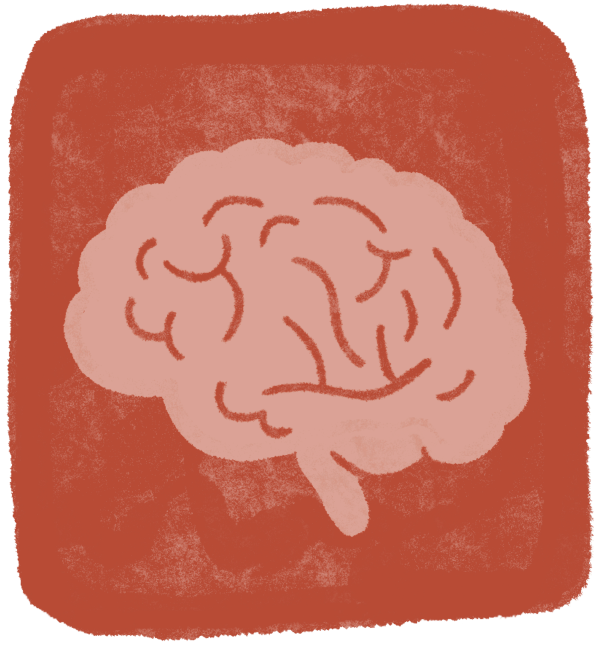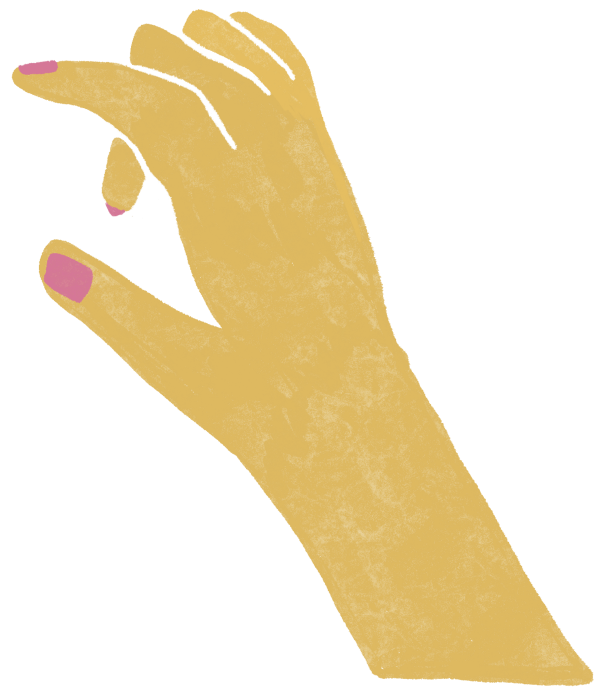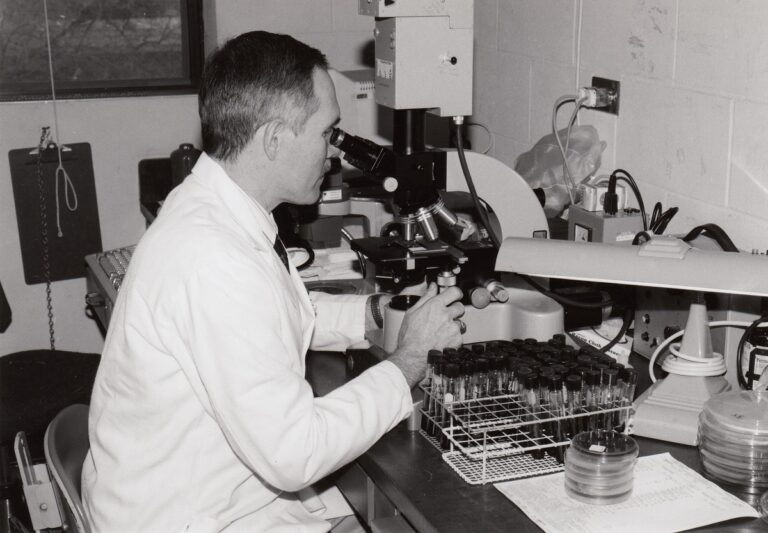At NDSU, Alyssa Hodges ’21, ’23, ’26 discovered a community ready to support her in ways she hadn’t expected.
Read More





NDSU students bring companionship and events to residents in memory care at Fargo’s Touchmark retirement community.
Story by Sarah Coomber | Illustrations by Leah Ecklund | August 23, 2024
“I’m angry,” said the woman, eyes darting side to side beneath a furrowed brow and neatly styled gray hair.
She sat, shoulders hunched, on a padded bench in a hallway decorated with cheerful paintings. Lowering her voice, she continued to mutter.
I had just entered Devonshire, the highest-level memory care neighborhood in Touchmark at Harwood Groves, a south Fargo retirement community.
Walking with me was Anna Strand ’27, moving with the confidence of an athlete, her face like sunshine. She stopped in front of the bench.

“Hi,” she said, addressing the woman by name. “We’re going to make bouquets. Do you want to join us?”
The older woman’s voice quieted. She looked up at Anna. “No. I’m angry,” she said and turned her gaze back to the floor.
“She often says this,” Anna explained softly, after we moved on. “But she’ll join us later.”
Anna’s assessment of the woman made perfect sense to me. I had watched my own mother struggle with dementia at the end of her life, moods swinging and behavior shifting. When her challenges became too great for my father to handle at home, they moved into Touchmark, where staff helped care for my mom as she drifted away.
Touchmark’s memory care environment is now the site of a pilot project for NDSU students and researchers. During the spring 2024 semester, Anna was among seven interns who visited on the weekends and led events for its 20 residents.


A morning in memory care
On a Saturday in April, four of the interns met up in Devonshire’s Cozy Corner room: Anna, a nutrition science major, and Addisyn Douty ’25, Taylor Gohdes ’25, and Tyler Hoang ’25, all exercise science majors. They set white vases and grocery store flowers on a long table and invited the residents to join them in making bouquets.
Soon the table was ringed by residents sitting in chairs. Doris Day sang “Que Sera, Sera” from an oldies playlist that wafted from the students’ portable speaker. For the next hour or so, residents came and went, some sitting down, choosing their own flowers to put in vases, others watching the students select and arrange flowers for them. One woman sank into a chair to watch and, after a few minutes, nodded off.
When “At the Hop” began to play, a woman wearing a blue fleece sweatshirt lit up. Sitting at the table, she began to snap her fingers, shimmy her shoulders, and bounce her feet to the 1958 hit.
“I love to dance!” she smiled.
“Brings back the memories, doesn’t it?” twinkled another woman, her hair short and white.
After a while, the angry woman we met earlier entered the room. Her eyes had changed from stormy to curious, and there was a hint of a spring in her step. Some at the table turned their heads to see who was coming, and her mood swung to irritated.
“Why are you looking over here?” she asked. “It’s like you’re expecting something straaaaange to happen.”
They turned back to their flowers.
Watching this woman navigate the morning’s happenings, I felt a sense of recognition.

I had observed my own mother swimming in similar emotional currents. Her confusion with everyday tasks often resulted in frustration. She would scowl and make herself immovable. Sometimes she would tell my dad she was leaving to go back to her hometown, far away, where she insisted she would rejoin family and friends, some of whom were no longer alive.
Dementia is caused by changes in the brain that lead to problems with memory, language, problem-solving, and other skills needed for everyday life. Alzheimer’s disease is the most common cause, accounting for 60% to 80% of all dementia cases. Others include vascular dementia, frontotemporal dementia, and Lewy body dementia.
According to the Alzheimer’s Association, in North Dakota alone approximately 14,000 people ages 65 and older are living with Alzheimer’s. Nationwide, there are nearly 7 million. By 2050, that number is predicted to rise to nearly 13 million, unless a cure or preventive measures are found.
Will anyone be left untouched?
They might not always remember the conversation we had the day before, but I think they get excited when we come, because they remember the way we make them feel.
Anna Strand ’27
A confluence of generations

The student internships and related research projects at Touchmark are funded by an endowment named “Improving the Quality of Life for Persons with Dementia and Alzheimer’s Disease.” It was created by Terry Scherling ’77, ’08 and her father, the late Darrol Schroeder ’52, ’08, in honor of Donna Jean (aka Jean or DJ) Schroeder ’49, Terry’s mother and Darrol’s wife.
Jean had been an economics major at NDSU and later became CEO of Carlson Travel Agency. She was an active community leader in Davenport, North Dakota, where she started an enrichment program for kindergartners, founded a theater group, and organized parades. Asked to coach a sport she’d never played, she led a softball team to a state championship.
“She was this energetic inspiration throughout our lives,” Terry said.
Jean remained active until the very end of her life, but when she faced dementia, she moved into Touchmark for memory care.
Terry and Darrol noticed that Touchmark’s events calendar was full, but on weekends the offerings were fewer and not as many staff were available to accompany memory care residents.
As Darrol visited Jean every day, he and Terry wondered about her neighbors whose families lived far away. They started imagining ways that NDSU students might help them stay engaged: Wouldn’t it be wonderful if students would practice their musical instruments in the hallway? And wouldn’t it be fun for physical education students to come and play a little soccer with a balloon?
Another thing Terry noticed was that after her mom entered memory care, she gained weight. She would stand in front of her mirror, looking at her stomach with consternation. Terry learned that dementia causes some people to lose touch with hunger sensations — they can’t tell when they need to eat or can’t tell when to stop.
Wanting to improve life for those living with dementia, Terry and Darrol brought their ideas to the NDSU Foundation and set up the endowment with a focus on nutrition and weekend enrichment activities.
The funding is making it possible for NDSU Health, Nutrition, and Exercise Sciences faculty Sherri Stastny ’88, ’89, ’07 and Ryan McGrath to hire student interns and set up research projects focused on nutrition and events. Sherri is a licensed registered dietitian and board-certified specialist in sports dietetics. Before joining the NDSU faculty in 2002, she worked as director of food and nutrition services in several health care systems. Ryan is the director of Healthy Aging North Dakota and is also on the faculty of the University of North Dakota’s department of geriatrics.


“I’m grateful that I have an opportunity to see some results during my lifetime,” said Terry, who retired as a major general in the U.S. Air Force, senior leader in the Department of Homeland Security, and founder and CEO of a national security consulting firm. “I hope that my parents would be pleased and proud of the impact that their gift has had on individuals with Alzheimer’s and the University that they love so much.”
Last fall, Sherri’s nutrition and dietetics students identified snacks as a place where changes might help residents keep their weights more stable. Four of her seniors spent three days meeting with Touchmark’s residents, nursing staff, and executive chef and exploring the memory care snack menu to make healthy changes.
“We all like our treats,” Sherri said, “but we tried to switch it up with nutrient-dense snacks.” Instead of a frosted sugar cookie, how about an oatmeal raisin cookie? They explored nut mixes, trail mixes, veggies and dips, and dried and fresh fruits.
To address the need for more things to do on weekends, Sherri and Ryan offered paid internships and training to students in the College of Health and Human Sciences using funds from the endowment.
Throughout spring semester, the interns took turns organizing events in the memory care area for weekend enrichment. Ahead of each visit, they ran them by Touchmark staff and their professors.
Some of the events included creating and enjoying healthy snacks, like making protein balls and smoothies. Others encouraged movement and social connection: songs and games, dancing, walking excursions, dyeing Easter eggs, planting gardens, creating pancake batter art, and bringing in musicians — including Taylor’s grandmother, who played hymns on the piano.
Anna described a pillow project, where participants tied together two fringed pieces of fabric. Although the task was too complicated for some, it still felt like a success.
“It was so cool seeing everyone here,” she said, “hearing people laughing and talking, some going on walks, some making pillows.”
It wasn’t about the craft — it was about being together.







Engaging with the gray tsunami
As students and residents connected weekly, Sherri and Ryan evaluated how their interactions affected both groups.
Based on questionnaires filled out by Touchmark staff, the researchers saw noticeable improvements in the older adults’ levels of social engagement, anxiety mitigation, emotional well-being, and overall quality of life after weekends when the student interns were on site.
“Do we find this program to be beneficial? Well, 10 out of 10 every single time,” Stephanie Doppler, clinical care manager at Touchmark, said. “Whenever there’s an activity, the anxiety goes down, because they’re not necessarily looking for their family or thinking they have to go somewhere or worried about what’s going on. They’re involved and engaged.”

Plus, she says, knowing an event is coming up gives residents something to look forward to. Afterward, they tend to be calmer and rest better in the evening. That’s good for the seniors as well as their caregivers.
“It’s rejuvenating for team members to have new people bring in new ideas,” Touchmark executive director Anne-Marie Fitz ’08 said.
In another area of research, Sherri and Ryan are studying how these experiences affect the student interns. They had the students fill out surveys at the beginning, middle, and end of the semester.
Preliminary data indicate the interns gained confidence in overall dementia care, professionalism, relationship building, working with the memory care group, and facing unexpected challenges. Ryan said the interns brought a “trailblazing attitude and willingness to try new things.”
They also got exposure to career paths in the field of elder care.
As the U.S. population ages, the gray tsunami is coming. According to the Alzheimer’s Association, the U.S. will need to nearly triple its number of geriatricians by 2050 to keep up with demand.
“No matter what we do, there’s more and more need,” Sherri said. “And if we can instill passion about helping older adults as a career, I’m all about that.”






Ripple effects
Having journeyed with my own mother through dementia, I was fascinated to watch the students navigating those unpredictable waters, meeting each resident where he or she was at on that particular day.
Their young hands, many with nails painted in optimistic pinks, assisted wrinkled fingers building fresh bouquets and painting cheery birdhouses as they chatted around the table.
The woman who started out angry in the hallway later sat down at the table and joined the activity, just as Anna predicted. She chose flowers and added them to her vase. Later, looking relaxed, even smiling, she painted a birdhouse.
Clearly the impacts of these weekend visits go far beyond keeping residents active.
“It’s really important, the way you make them feel,” Anna observed. “They might not always remember the conversation we had the day before, but I think they get excited when we come, because they remember the way we make them feel.”
Nearby, Addisyn helped the woman with short, white hair paint a birdhouse pink and blue. The woman asked what year she was in school.
“A junior,” Addisyn answered.
The woman patted her on the arm.
“I’m glad you’re here,” she said.



Sarah Coomber is a Moorhead-based writing consultant who dives deep to bring her subjects to life. She currently publishes a weekly e-newsletter about life in the sandwich generation at Sandwich Season and is the author of The Same Moon (Camphor Press, 2020), a memoir about how running away to Japan helped her find her way home.
Share This Story
Related Stories
20 Years of Front-line Research
Peter Iwen '76 is the recipient of the 2023 Alumni Achievement Award, which recognizes alumni who have attained outstanding professional accomplishments.
Read More
